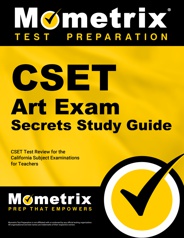The CSET program was developed by the Commission on Teacher Credentialing (CTC) to help teacher candidates to meet basic skills and subject matter competency. The CSET Art practice questions assess your knowledge across the domains of art and expression, as well as the history, culture, and theory of art. Part of your grade is based upon your art portfolio.
What is the CSET Art exam?
The California Subject Examinations for Teachers (CSET) were designed and implemented as a crucial step in the State of California’s teacher credentialing process. The CSET Art exam is specific to prospective teaching candidates who wish to teach Art in California public schools. The CSET Art exam, consisting of two subtests, was designed to ensure California students receive a highly effective, high-quality education across the board. If you are seeking to become an art teacher in the State of California, you may be required to take the CSET Art exam.
What are the eligibility requirements to take the CSET Art exam?
The CSET Art exam is only one part of the credentialing process for prospective California teachers. To ensure you meet every necessary criterion, check with the administrators of your state-approved teacher preparation program and the California Commission on Teacher Credentialing before registering to sit for the CSET Art exam.
How much does the CSET Art exam cost?
The CSET Art exam consists of two subtests. You will pay $133 for Subtest I and $134 for Subtest II, or $267 if you choose to take both subtests together. Test cancellations must be completed at least 24 hours before your scheduled test date. You will receive a full refund within four weeks of your request after you submit a withdrawal request. If you do not cancel your test, fail to show up, or neglect to submit a withdrawal form, you will not receive a refund.
What is the passing score for the CSET Art exam?
The passing score for the CSET Art exam is 220 per subtest. In fact, 220 is the passing score for all CSET subtests. Your official score report will be available within 7 weeks of your scheduled test date. If you do not receive the score you need to pass the CSET Art exam, you can retake each subtest as many times as necessary.
What does the CSET Art exam cover?
The CSET Art exam consists of two subtests (140 and 141). Both subtests are computer-based tests (CBT) consisting of 50 multiple-choice questions and 4 constructed-response questions a piece. You will be given 2 hours and 45 minutes per test, for a total of 5 hours and 30 minutes for the entire exam (consisting of both subtests). Important to note is that Subtest II also requires the submission of an art portfolio. Make sure that you come prepared with high-quality photographic representations of your artwork to submit at the test center on the day of your exam.
Each CSET Art subtest covers standards-relevant content related to specific educational domains. The domains, number of multiple-choice and constructed-response questions, and basic content are as follows:
Subtest I:
- Aesthetic valuing, 20 multiple-choice questions, 1 extended constructed-response question
- Deriving meaning, making informed judgments, etc.
- Cultural and historical context of visual arts and artistic perception, 15 multiple-choice questions, 1 short (focused) constructed-response question
- Art and society, world arts, etc.
- Artistic perception, 15 multiple-choice questions, 1 short (focused) constructed-response question, 1 short (focused) drawing
- Elements of art, principles of design, etc.
Subtest II:
- Creative expression, 30 multiple-choice questions, 1 extended (portfolio-based) constructed-response question, 1 short (focused) constructed-response question, 1 short (focused) drawing
- Creating original art, two-dimensional art and design, three-dimensional art and design, media, emerging art forms, etc.
- Connections, applications, relationships, 10 multiple-choice questions, 1 short (focused) constructed-response question
- Applications and connections between visual arts and outside disciplines, visual literacy, art-related careers, etc.
- History and theories of learning in art, 10 multiple-choice questions
- Theories of learning in art, art and human development, etc.
Test Preparation
Now that you have a better understanding of the expectations, content, and basic structure of the CSET Art exam, what comes next? The most effective means of ensuring your success on the CSET Art exam is to thoroughly prepare using the most comprehensive test preparation materials available to consumers. Mometrix Test Preparation has developed just what you need in the CSET Secrets study guide. The CSET Secrets study guide includes authentic CSET exam content, as well as experts’ tips on reducing test anxiety, recalling important information, and earning the high score you need to pass the CSET Art exam on your first attempt. As a companion to the CSET Secrets study guide, Mometrix Test Preparation has also developed a comprehensive set of CSET Exam Flashcards and an in-depth CSET Practice Test. Read the CSET Secrets study guide, assess your knowledge, skills, and abilities with the CSET Flashcards and CSET Practice Test, and pass the CSET Art exam on your first attempt.




